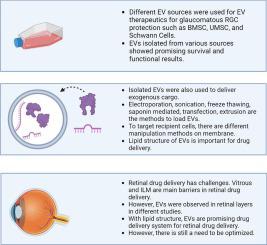当前位置:
X-MOL 学术
›
J. Control. Release
›
论文详情
Our official English website, www.x-mol.net, welcomes your feedback! (Note: you will need to create a separate account there.)
Utilizing extracellular vesicles as a drug delivery system in glaucoma and RGC degeneration
Journal of Controlled Release ( IF 10.5 ) Pub Date : 2024-06-22 , DOI: 10.1016/j.jconrel.2024.06.029 Esmahan Durmaz 1 , Lujien Dribika 2 , Matyas Kutnyanszky 1 , Ben Mead 1
Journal of Controlled Release ( IF 10.5 ) Pub Date : 2024-06-22 , DOI: 10.1016/j.jconrel.2024.06.029 Esmahan Durmaz 1 , Lujien Dribika 2 , Matyas Kutnyanszky 1 , Ben Mead 1
Affiliation

|
Retinal diseases are the leading cause of blindness, resulting in irreversible degeneration and death of retinal neurons. One such cell type, the retinal ganglion cell (RGC), is responsible for connecting the retina to the rest of the brain through its axons that make up the optic nerve and is the primary cell lost in glaucoma and traumatic optic neuropathy. To date, different therapeutic strategies have been investigated to protect RGCs from death and preserve vision, yet currently available strategies are restricted to treating neuron loss by reducing intraocular pressure. A major barrier identified by these studies is drug delivery to RGCs, which is in large part due to drug stability, short duration time at target, low delivery efficiency, and undesired off-target effects. Therefore, a delivery system to deal with these problems is needed to ensure maximum benefit from the candidate therapeutic material.
中文翻译:

利用细胞外囊泡作为青光眼和 RGC 变性的药物递送系统
视网膜疾病是导致失明的主要原因,导致视网膜神经元不可逆的退化和死亡。其中一种细胞类型是视网膜神经节细胞(RGC),它负责通过构成视神经的轴突将视网膜连接到大脑的其他部分,并且是青光眼和创伤性视神经病变中丢失的主要细胞。迄今为止,已经研究了不同的治疗策略来保护 RGC 免于死亡并保留视力,但目前可用的策略仅限于通过降低眼内压来治疗神经元损失。这些研究发现的一个主要障碍是向 RGC 的药物递送,这在很大程度上是由于药物稳定性、到达目标的持续时间短、递送效率低以及不希望的脱靶效应。因此,需要一种解决这些问题的递送系统,以确保候选治疗材料的最大益处。
更新日期:2024-06-22
中文翻译:

利用细胞外囊泡作为青光眼和 RGC 变性的药物递送系统
视网膜疾病是导致失明的主要原因,导致视网膜神经元不可逆的退化和死亡。其中一种细胞类型是视网膜神经节细胞(RGC),它负责通过构成视神经的轴突将视网膜连接到大脑的其他部分,并且是青光眼和创伤性视神经病变中丢失的主要细胞。迄今为止,已经研究了不同的治疗策略来保护 RGC 免于死亡并保留视力,但目前可用的策略仅限于通过降低眼内压来治疗神经元损失。这些研究发现的一个主要障碍是向 RGC 的药物递送,这在很大程度上是由于药物稳定性、到达目标的持续时间短、递送效率低以及不希望的脱靶效应。因此,需要一种解决这些问题的递送系统,以确保候选治疗材料的最大益处。
















































 京公网安备 11010802027423号
京公网安备 11010802027423号